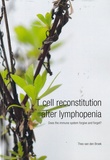T cell reconstitution after lymphopenia
Does the immune system forgive and forget?
Summary
Throughout life, in absence of disease, the size and composition of the peripheral T-lymphocyte pool is tightly regulated and maintained at relatively constant levels. This T-cell homeostasis depends on two sources: thymopoiesis resulting in the generation of new T-cells and via expansion of T-cells already present in the circulation, termed homeostatic proliferation. Although the thymus is responsible for the production of new naïve T-cells, homeostatic proliferation seems to be the prominent contributor to T cell maintenance in adult life. We now show that removal of the neonatal thymus, due to cardiac surgery, results in a drastic decrease of T-cells (especially naïve T-cells) and a previously unknown functional differentiation within the naïve T cell compartment. Of further interest, later in life functional thymic tissue regenerated in most of the children and resulted in restoration of naïve T-cell function, numbers and other signs of premature immune aging. However, we also demonstrate that autoantibodies are detected in the majority of these patients, independently of thymic tissue regeneration. It is for now unknown if these autoantibodies will ever or prematurely result into clinical autoimmune disease later in life. We therefor suggest partial removal of the thymus during cardiac surgery when possible. The role of the thymus in immune reconstitution is also apparent after stem cell transplantation (SCT). We further looked into the role of the thymic-derived T-cells (donor) and host T-cells in the experimental murine bone marrow transplantation (BMT) setting by utilizing different markers for host and donor cells. In an experimental murine arthritis model we found that autologous BMT resulted in functional renewal of the T-cell and regulatory T-cell (Treg) compartment, via thymic-derived donor T-cell expansion. In the human setting we analyzed the TCR (T-cell receptor) diversity of T-cells, as diversity increases with increased thymic output. Interestingly, the TCR repertoire of Treg cells was much narrower than non-Treg cells in autoimmune disease, but broadened after autologous stem cell transplantation (aSCT). This Treg repertoire expansion post-aSCT seemed to be correlated with clinical outcome post-aSCT, as disease relapse occurred in the setting of a narrow Treg TCR diversity post-aSCT. These data indicate that aSCT-mediated amelioration of autoimmune disease involves renewal of the Treg pool. Juvenile idiopathic arthritis (JIA) can be treated via SCT in cases of very severe clinical disease. However many different therapeutics can be utilized to treat the different types of JIA prior to SCT. The current classification of JIA types is primarily based on joint involvement, but might actually represent disease activity instead of a different disease type. Analysis of immunological biomarkers showed that a homogenous group of early-onset (<6 years of age at disease onset) anti-nuclear antibody-positive JIA patients had a distinct cytokine profile, in contrary to the current JIA subtypes. Supporting the reclassification of JIA types. This new homogenous groups has a higher risk of developing iridocyclitis and warrants a different clinical and therapeutic approach. Hereby, with this new suggested classification getting a step closer to patient-tailored medicine.
